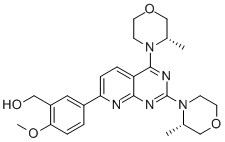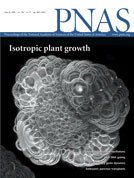
AZD8055 is a novel ATP-competitive inhibitor of mTOR kinase (both complexes mTORC1 and mTORC2) with an IC50 of 0.8 nM.Particularly,AZD8055 fully inhibited multisite eIF4E-binding protein1 phosphorylation,subsequently blocking protein translation, which was in contrast to the effects of rapamycin. In addition, the mTORC1-dependent PI3K/Akt feedback activation was fully abrogated in AZD8055-treated AML cells. Significantly, AZD8055 decreased AML blast cell proliferation and cell cycle progression, reduced the clonogenic growth of leukemic progenitors and induced caspase-dependent apoptosis in leukemic cells but not in normal immature CD34+ cells.

Cell Death and Disease. 2018 Jan 26;9:137-52.
Downregulation of MCL-1 and upregulation of PUMA using mTOR inhibitors enhance antitumor efficacy of BH3 mimetics in triple-negative breast cancer
AZD8055 purchased from AbMole

Proc Natl Acad Sci U S A. 2015 Mar 17;112(11):E1288-96.
Assessment of ABT-263 activity across a cancer cell line collection leads to a potent combination therapy for small cell lung cancer.
AZD8055 purchased from AbMole
| Cell Experiment | |
|---|---|
| Cell lines | H838 and A549 cells line |
| Preparation method | Growth inhibition and autophagy analysis. For growth inhibition and acridine staining, cells were exposed to increasing concentrations of AZD8055 for 72 to 96 h and stained for cell nuclei (0.03 mg/mL Hoechst 33342) and acidic vesicles (1 μg/mL acridine orange). Images were captured at 450 and 536 nm on an ArrayScan II (Cellomics) platform, and the percentage of acidic vesicles and the number of cells were quantified. For LC3 assessment, cells were exposed to e64d/pepstatin (10 μg/mL) for 30 to 90 min before incubation with AZD8055. Cells were lysed on ice and analyzed by immunoblotting. |
| Concentrations | 0–3 μmol/L |
| Incubation time | 72~96 h |
| Animal Experiment | |
|---|---|
| Animal models | Mice bearing U87-MG xenografts or A549 xenografts |
| Formulation | dissolved in captisol (CyDex) and diluted to a final captisol concentration of 30% (w/v) |
| Dosages | 0.1 mL/10 g of body weight once or twice daily |
| Administration | oral gavage |
| Molecular Weight | 465.54 |
| Formula | C25H31N5O4 |
| CAS Number | 1009298-09-2 |
| Solubility (25°C) | DMSO 50 mg/mL |
| Storage |
Powder -20°C 3 years ; 4°C 2 years In solvent -80°C 6 months ; -20°C 1 month |
| Species | Mouse | Rat | Rabbit | Guinea pig | Hamster | Dog |
| Weight (kg) | 0.02 | 0.15 | 1.8 | 0.4 | 0.08 | 10 |
| Body Surface Area (m2) | 0.007 | 0.025 | 0.15 | 0.05 | 0.02 | 0.5 |
| Km factor | 3 | 6 | 12 | 8 | 5 | 20 |
| Animal A (mg/kg) = Animal B (mg/kg) multiplied by | Animal B Km |
| Animal A Km |
For example, to modify the dose of Compound A used for a mouse (20 mg/kg) to a dose based on the BSA for a rat, multiply 20 mg/kg by the Km factor for a mouse and then divide by the Km factor for a rat. This calculation results in a rat equivalent dose for Compound A of 10 mg/kg.
| Related mTOR Products |
|---|
| Thioether-cyclized helix B peptide, CHBP
Thioether-cyclized helix B peptide, CHBP can improve metabolic stability and renoprotective effect through inducing autophagy via inhibition of mTORC1 and activation of mTORC2. |
| 10-Hydroxy-2-decenoic acid
10-Hydroxy-2-decenoic acid (10-HDA) is the major lipid component of royal jelly produced by honeybees. |
| mTOR inhibitor-11
mTOR inhibitor-11 is a brain-penetrant mTOR inhibitor (IC50: 21 nM for pS6). |
| mTOR inhibitor-12
mTOR inhibitor-12 is a selective brain penetrant mTOR inhibitor without genotoxicity risk. |
| Royleanone
Royleanone, a diterpenoid isolated from plants, inhibits the proliferation of cancer cells by inducing cell cycle arrest and mitochondria-mediated apoptosis. |


Products are for research use only. Not for human use. We do not sell to patients.
© Copyright 2010-2023 AbMole BioScience. All Rights Reserved.
